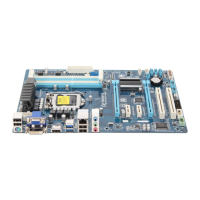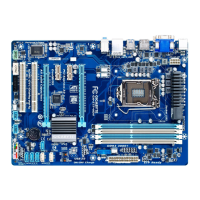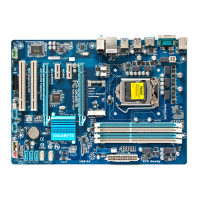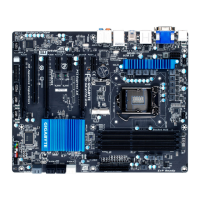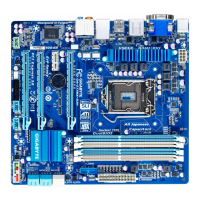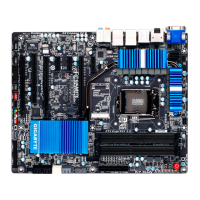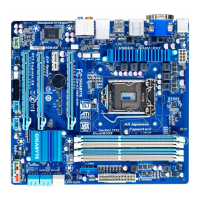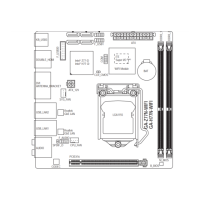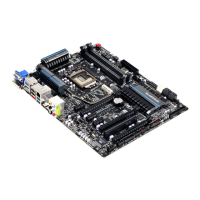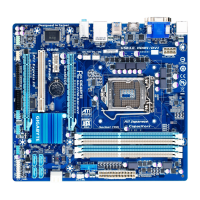Do you have a question about the Gigabyte GA-Z77-D3H and is the answer not in the manual?
Legal notices, copyright, and disclaimers for the manual.
Explains the types of documentation provided by GIGABYTE.
Guide on how to find the specific revision number of the motherboard.
Lists the standard items included in the motherboard's packaging.
Lists optional accessories that may be purchased separately.
Essential safety guidelines and procedures to follow before installing hardware.
Detailed specifications of the motherboard's hardware components and features.
Step-by-step instructions for installing the CPU and its cooling solution.
Guide on how to install memory modules, including dual-channel configuration.
Instructions for properly installing expansion cards into available slots.
Overview and description of all connectors available on the motherboard's back panel.
Detailed description of all internal connectors on the motherboard for system assembly.
Displays the initial logo screen that appears when the computer boots.
Overview of the BIOS setup program's main interface and navigation.
Menu for configuring CPU/memory clock, frequency, and voltages for performance tuning.
Settings for system language, date, time, and SATA port information.
Options for configuring boot order, system startup features, and passwords.
Settings for onboard devices like SATA controllers, USB, audio, and LAN.
Options to configure system power saving features and wake-up settings.
Options for saving BIOS changes, loading defaults, and exiting the setup.
Guide to installing essential chipset drivers from the motherboard disk.
Information on installing GIGABYTE utilities and free software.
Provides content descriptions for the drivers provided on the disk.
Contact information for GIGABYTE headquarters and branch offices.
Displays basic system information about the hardware.
Links to GIGABYTE's website for downloading the latest BIOS, drivers, and applications.
Quick links to install recently developed GIGABYTE utilities.
Utility for quick system data compression, backup, and restoration.
Information on updating the BIOS using Q-Flash and @BIOS utilities.
Tool for fine-tuning system settings, overclocking, and voltage adjustments.
Tool for sharing data and resources between computers on a network.
Utility for quick RAID 0 configuration and management of SATA controllers.
Feature to enable system power saving via a Bluetooth cell phone.
Technology enabling faster system resume from sleep states using an SSD.
Technology for automatic program updates while the system is suspended.
Technology to accelerate system performance using an SSD as a cache.
Detailed steps for configuring SATA controllers and RAID arrays.
Guide for setting up audio jacks for multi-channel speaker configurations.
Procedures and FAQs to help diagnose and solve common system issues.
| ECC | No |
|---|---|
| Non-ECC | Yes |
| Memory voltage | 1.5 V |
| Memory channels | Dual-channel |
| Memory slots type | DIMM |
| Number of memory slots | 4 |
| Supported memory types | DDR3-SDRAM |
| Maximum internal memory | 32 GB |
| Supported memory clock speeds | 1066, 1333, 1600 MHz |
| Supported memory module capacities | 16GB, 1GB, 2GB, 4GB, 8GB |
| System bus rate | 5 GT/s |
| Processor socket | LGA 1155 (Socket H2) |
| Processor manufacturer | Intel |
| Compatible processor series | Intel Core i3, Intel Core i5, Intel Core i7 |
| Maximum number of SMP processors | 1 |
| USB 2.0 connectors | 3 |
| Number of SATA III connectors | 2 |
| Number of Parallel ATA connectors | 0 |
| Headphone outputs | 5 |
| USB 2.0 ports quantity | USB 2.0 ports have a data transmission speed of 480 Mbps, and are backwards compatible with USB 1.1 ports. You can connect all kinds of peripheral devices to them. |
| Audio chip | VIA VT2021 |
| Cooling type | Passive |
| Component for | PC |
| Motherboard chipset | - |
| PC health monitoring | CPU, FAN, Temperature |
| Audio output channels | 7.1 channels |
| Motherboard form factor | ATX |
| Compatible operating systems | Windows 7/XP |
| RAID levels | 0, 1, 5, 10 |
| Supported storage drive interfaces | SATA II, SATA III |
| Cables included | SATA |
| PCI Express slots version | 2.0, 3.0 |
| PCI Express configurations | 1x16+1x4 |
| Graphics card | HD Graphics |
| OpenGL version | 3.2 |
| DirectX version | 11 |
| Maximum graphics card memory | 1696 MB |
| Parallel processing technology support | 2-Way CrossFireX, LucidLogix Virtu |
| Controller interface type | Intel Z77 |
| Wi-Fi standards | Not supported |
| Networking features | 10/100/1000 Mbit/sec |
| Ethernet interface type | Gigabit Ethernet |
| BIOS type | EFI AMI |
| ACPI version | 2.0a |
| BIOS memory size | 64 Mbit |
| Depth | 244 mm |
|---|---|
| Width | 305 mm |
